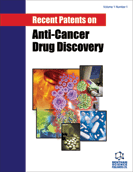
Abstract
Background: Vernonia cinerea (VC) is an important medicinal plant used in the indigenous system of therapy. In ethnomedicine, VC has demonstrated anticancer properties. However, the mechanisms of action VC is not known.
Objective: To establish the anticancer mechanisms of ‘bioactive fractions of VC’ on human adenocarcinoma cells.
Methods: The IC50 values of characterized VC extract and fractions in human adenocarcinoma and normal epithelial cells were determined using Sulforhodamine B (SRB) assay. Acridine Orange- Ethidium Bromide (AO-EB) assay/Hoechst 33342 assay, Comet assay, and Cell cycle analysis were used to determine apoptosis, genotoxicity, and cell cycle-specific changes in cancer cells, respectively. Rhodamine 123 (Rho-123) efflux assay and Mitoxantrone (MX) efflux assay were used to assess the inhibition of Multidrug Resistance (MDR) transporters.
Results: The dichloromethane fraction of VC (VC-DM) imparted dose-dependent cytotoxicity in human adenocarcinoma cells with fewer effects in human normal epithelial cells. This ‘sesquiterpenoids’ enriched fraction (VC-DM) induced apoptosis, DNA damage, genotoxicity, and G2/M phase arrest in human adenocarcinoma cells. Interestingly, VC-DM significantly inhibited the functional activity of MDR transporters (ABCB1 and ABCG2) and caused ‘synergistic cytotoxic effects’ with anticancer drugs in human adenocarcinoma cells.
Conclusion: The bioactivity guided fractionation of VC revealed that the specific ‘sesquiterpenoids enriched fraction’ (VC-DM) imparted cytotoxicity in human adenocarcinoma cells with fewer effects on normal cells. Mechanistic studies have shown that VC-DM induced apoptosis, DNA damage, genotoxicity, cell cycle arrest (G2/M), inhibited the functional activity of MDR transporters (ABCB1 and ABCG2), and produced ‘synergistic cytotoxic effects’ (combinatorial treatments with anticancer drugs) in human adenocarcinoma cells. Taken together, the findings of this study emphasize and validates VC-DM as a promising ‘anticancer agent’ against human adenocarcinomas, including those with a multi-drug resistant phenotype.
Keywords: Apoptosis, cytotoxicity, cell cycle arrest, dichloromethane fraction of Vernonia cinerea, genotoxicity, modulation of drug efflux transporters.
[http://dx.doi.org/10.1016/j.drup.2016.05.001] [PMID: 27449595]
[http://dx.doi.org/10.1016/j.jep.2014.10.010] [PMID: 25456421]
[http://dx.doi.org/10.1007/978-981-10-8548-2_10]
[http://dx.doi.org/10.1016/B978-0-08-102081-4.00002-2]
[http://dx.doi.org/10.1016/j.phytol.2019.04.003]
[http://dx.doi.org/10.1080/14786419.2014.981814] [PMID: 25426778]
[http://dx.doi.org/10.1248/cpb.51.425] [PMID: 12672998]
[http://dx.doi.org/10.1177/0960327111414279] [PMID: 21708884]
[http://dx.doi.org/10.3109/08923973.2010.547501] [PMID: 21247369]
[http://dx.doi.org/10.1016/j.phymed.2018.09.211] [PMID: 30599904]
[http://dx.doi.org/10.1177/1534735414564423] [PMID: 25549922]
[http://dx.doi.org/10.1016/j.drup.2014.11.002] [PMID: 25554624]
[http://dx.doi.org/10.2174/138920111795164048] [PMID: 21118094]
[http://dx.doi.org/10.1016/j.canlet.2015.10.010] [PMID: 26499806]
[http://dx.doi.org/10.1038/s41568-018-0005-8] [PMID: 29643473]
[http://dx.doi.org/10.1208/s12248-015-9757-1] [PMID: 25840885]
[http://dx.doi.org/10.1016/j.phymed.2018.09.169] [PMID: 30466981]
[http://dx.doi.org/10.3390/molecules24234383] [PMID: 31801248]
[http://dx.doi.org/10.22270/jddt.v9i1.2227]
[http://dx.doi.org/10.21769/BioProtoc.1984] [PMID: 28573164]
[http://dx.doi.org/10.12659/MSMBR.893327] [PMID: 25664686]
[http://dx.doi.org/10.1101/pdb.prot087205]
[http://dx.doi.org/10.1007/978-1-4939-7346-0_11]
[http://dx.doi.org/10.1007/978-1-4939-7306-4_21]
[http://dx.doi.org/10.1021/acs.molpharmaceut.8b00457] [PMID: 30052463]
[http://dx.doi.org/10.1007/978-981-10-8064-7_6]
[http://dx.doi.org/10.11648/j.mc.20180602.14]
[http://dx.doi.org/10.1038/nature.2016.19364] [PMID: 26911756]
[http://dx.doi.org/10.1039/C9NP00062C] [PMID: 32104815]
[http://dx.doi.org/10.1007/s10600-018-2311-5]
[http://dx.doi.org/10.2174/0929867323666160510123255] [PMID: 27160533]
[http://dx.doi.org/10.1080/07352689.2016.1145956]
[http://dx.doi.org/10.1177/1934578X1601100103]
[http://dx.doi.org/10.4103/0973-1296.153077] [PMID: 25829763]
[http://dx.doi.org/10.1038/s41556-018-0201-5] [PMID: 30224761]
[http://dx.doi.org/10.1016/j.semcancer.2020.03.008]
[http://dx.doi.org/10.1038/nrc.2016.138] [PMID: 28127048]
[PMID: 30721649]
[http://dx.doi.org/10.1186/s40880-017-0219-2] [PMID: 28646911]
[http://dx.doi.org/10.1007/978-3-030-32857-3_16]
[http://dx.doi.org/10.1016/j.ejmech.2019.05.027] [PMID: 31103904]
[http://dx.doi.org/10.1016/j.canlet.2017.03.011] [PMID: 28302530]
[http://dx.doi.org/10.1016/j.canlet.2018.01.021] [PMID: 29331420]
[http://dx.doi.org/10.1016/j.bcp.2018.10.028] [PMID: 30431011]
 49
49



























